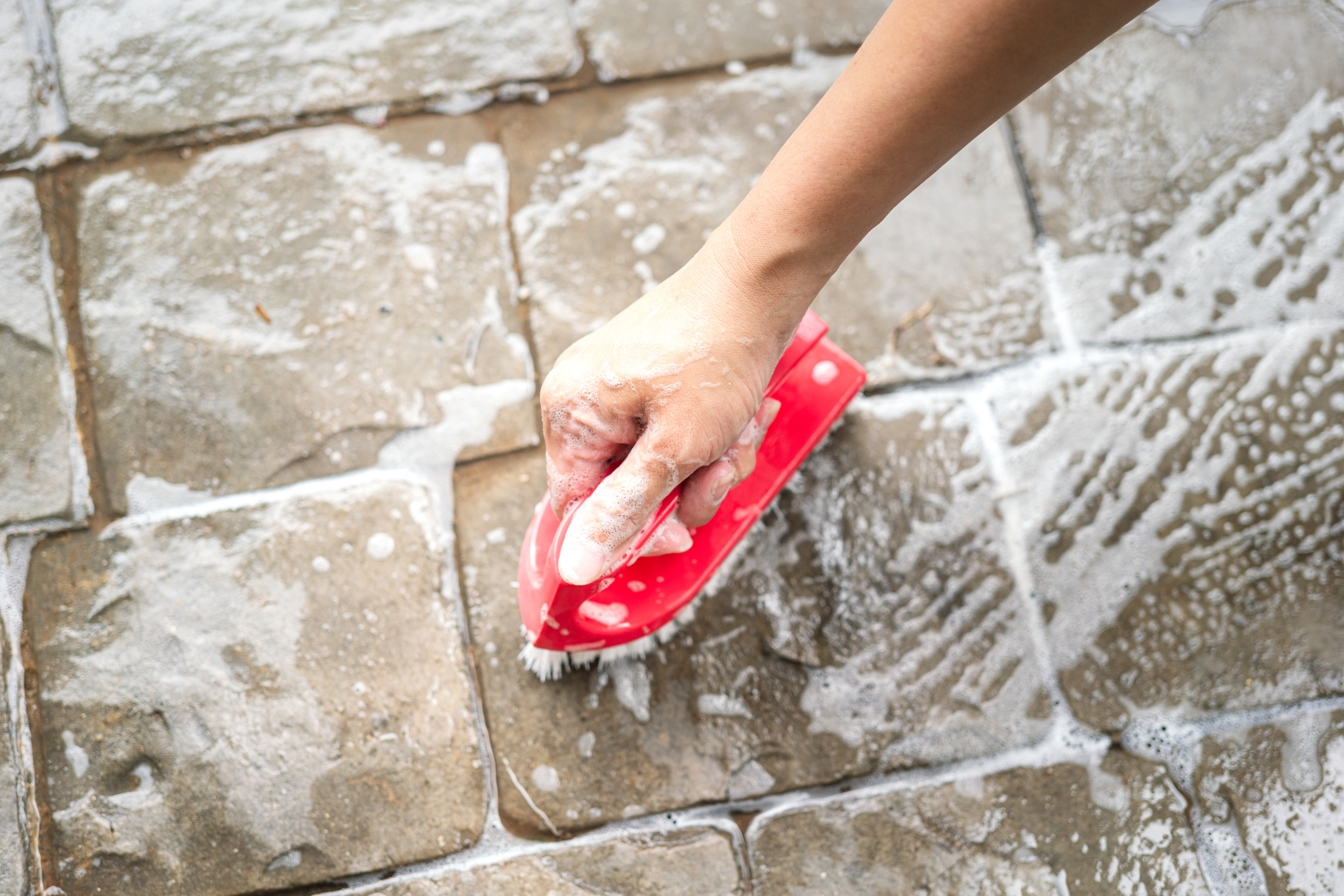There is so much to love about autumn in the Greater Triangle. The richly colored leaves and cooler temperatures provide a stunning backdrop for hiking, football, and roasting marshmallows in the backyard. Despite all the fun, there can be a few downsides to autumn beauty…such as the stains from falling leaves on your outdoor patio. Whether your patio is made of pavers or concrete, decomposing leaves can create unsightly stains on their surfaces. Luckily, these stains can be removed in a few simple steps.

What you’ll need when cleaning a concrete patio:
- Cleaning solution: equal parts white vinegar thoroughly mixed with equal parts warm water.
- Stiff bristled scrub brush or broom.
To remove stains from your Raleigh- area concrete patio, you should use a mixture of equal parts white vinegar and warm water. This combination is effective for most stains on concrete patios. This includes brush concrete finish patios and stain-and-stamp concrete patios. For tougher stains, you might consider using a dedicated concrete cleaner or degreaser. For oil stains on concrete such as once which may have occurred from food spills or while grilling outside a baking soda, or standard dish detergent can be effective. Archadeck of Raleigh always urges you to check the type of patio material before using any cleaning agent to avoid damage.
What you’ll need when cleaning a paver patio:
- Cleaning solution: 10 parts water thoroughly mixed with 1 part bleach or a specially formulated paver cleaner of your choice. (You can find paver and hardscape cleaner at your local hardware store.)
- Stiff bristled scrub brush or broom.
How to Remove Stains from Patios
 Step 1: First remove all loose debris and dirt with a broom and a garden hose or pressure washer. Be careful with power washing pavers, so you don’t expose the aggregate on the surface of the paver.
Step 1: First remove all loose debris and dirt with a broom and a garden hose or pressure washer. Be careful with power washing pavers, so you don’t expose the aggregate on the surface of the paver.
Step 2: Protect nearby plants and other accessories, so they don’t get direct exposure to the cleaning solution.
Step 3: Dampen the pavers and pour your appropriate cleaning solution on the affected area, letting it sit for about 5 minutes. If you have a specific stain that might be more challenging such as rust, red wine, or grease, using a specialized paver cleaner will achieve the best results.
Step 4: Scrub the affected area with a stiff-bristled brush or broom until the stain is gone. Be sure to rinse away the cleaning solution with water thoroughly.

Key Patio Cleaning Points:
Vinegar solution: Vinegar solution is a common patio cleaning method. The key to success is to mix equal parts white vinegar and warm water, apply to the stain, let it sit, scrub with a brush, and rinse.
Baking soda: Recommended for may food-based oil stains. This method consists of simply making a paste with baking soda and water. Apply the paste to the stain, let it sit, then scrub and rinse.
Commercial cleaners: For stubborn stains, use a concrete cleaner or degreaser specifically designed for patios.
Pressure washer: A pressure washed is a powerful tool to remove dirt and grime from your patio. We suggest to always use with caution and ensure you are familiar with its operation.
Always Check your patio material: Always check the type of material your patio is built from before using any cleaning agent. Some patio materials like limestone can be damaged by acidic solutions like vinegar. Always be cognizant of your patio’s makeup to avoid irreversible damage. And as always, when in doubt, consult a professional.
General Patio Cleaning
If your patio has not been cleaned in some time, spot cleaning can make your patio look blotchy. To clean the entire surface of your patio, use a paver cleaner. Follow the directions on the bottle, spraying the cleaner on the surface of the patio, and scrubbing it with a push broom. Rinse your patio until all the cleaner is removed to avoid leaving a film.
Leaf Stain Prevention
Regular removal of fallen leaves from your patio is the best way to prevent stains from organic decomposition. Using a broom or a leaf blower, remove all leaves as often as possible. Additional protection can come from sealing your concrete pavers. Belgard recommends sealing patio pavers every three to five years to maintain color and beauty. While sealing won’t prevent all stains, it can make stains easier to remove.
At Archadeck of Raleigh-Durham, our commitment to our clients extends beyond the building process. If you would prefer to hire a professional to clean or seal your patio (rather than do it yourself), we would be happy to recommend a local service provider. Give us a call at (919) 446-5585. We look forward to helping you.
Did you like what you read here? Join our newsletter list here to get an outdoor living update straight to your inbox four times a year. We promise not to spam!